Bikepacking with your dog, often called dogpacking, might seem daunting at first. However, with the right knowledge and gear, it can become an incredibly rewarding experience for both you and your furry friend. Just like us, dogs thrive on adventure, exploration, and spending time outdoors. This guide will walk you through everything you need to know about dogpacking, with a special focus on using Bike Dog Trailers to ensure a comfortable and safe journey for your canine companion.
Preparing for Your Adventure: Vet Visit & Health Checks
Before embarking on any bikepacking trip with your dog, a visit to the veterinarian is crucial. Think of it as a pre-departure check-up for your adventure buddy. Your vet will confirm your dog is healthy enough for the rigors of travel and can advise on any specific health concerns based on your planned route and destination. This visit becomes absolutely essential if you’re planning to cross international borders, as specific health documents are often required.
At a minimum, ensure your dog’s vaccinations are up-to-date, considering the regions you’ll be riding through. Vaccination regulations can vary even within your own country. For international travel, research specific requirements well in advance, as some borders mandate vet visits or medications within a particular timeframe before entry. Always carry physical copies of health and travel documents and consider keeping digital backups on your phone. Stocking up on essential medications before you leave can also simplify things on the road, reducing worries about finding specific treatments in unfamiliar locations. Preparation is key to a smooth and safe start to your dogpacking adventure.
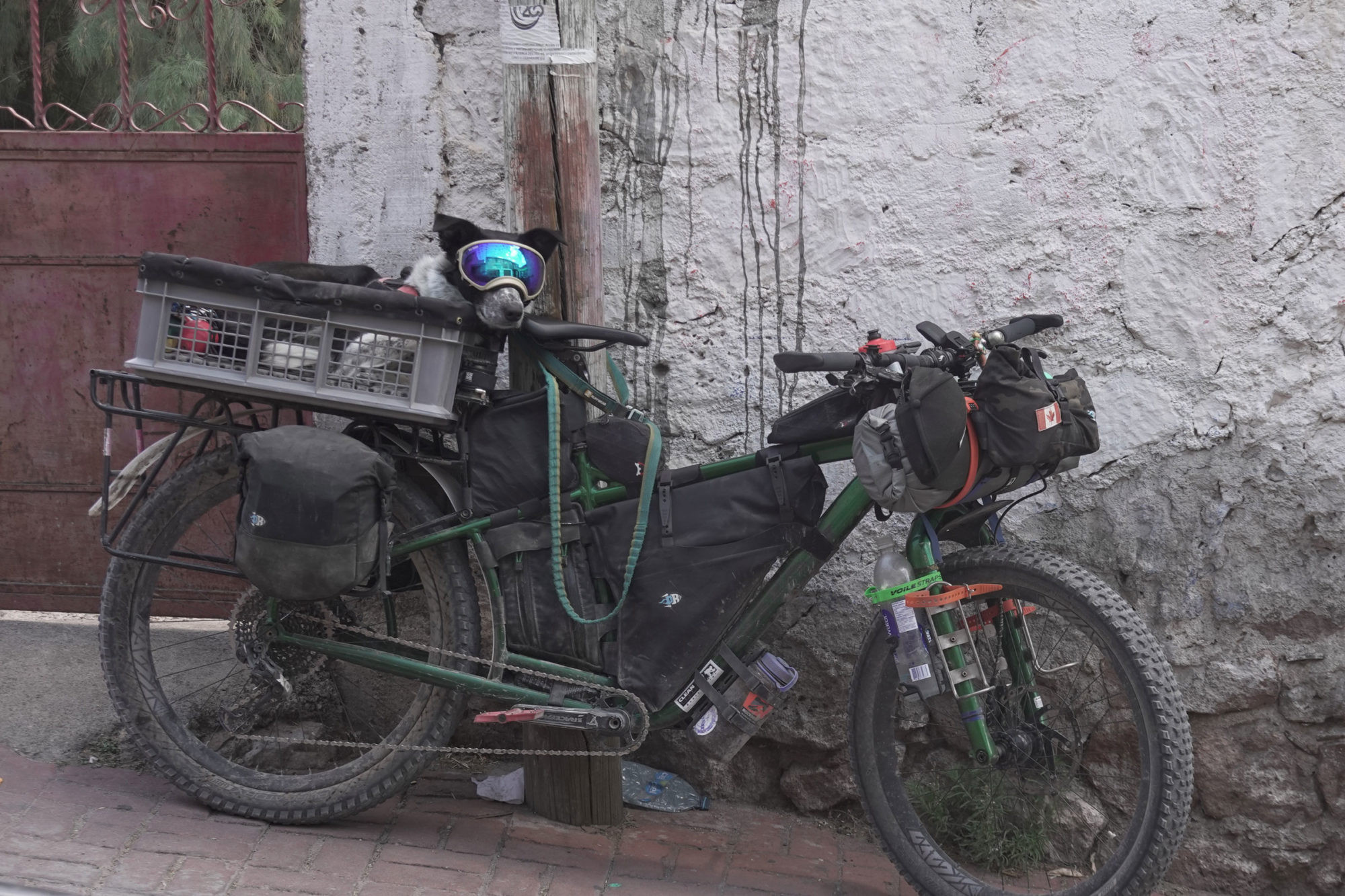 Dogpacking with a happy dog in a trailer
Dogpacking with a happy dog in a trailer
Food and Hydration for Your Dog on the Trail
Food
For shorter bikepacking trips, pre-packaging your dog’s food in individual portions, similar to how you manage your own meals, is a convenient approach. Remember, just like humans, dogs require increased calorie intake when engaging in physical activities like bikepacking. Opting for high-quality dog food, low in fillers, ensures your dog receives nutrient-dense meals, contributing to their overall health and energy levels throughout the tour.
On longer expeditions, purchasing dog food along the way becomes necessary. Availability and brands will vary depending on your travel destinations. To minimize digestive issues when switching food brands, gradually blend new food with the old. While some dogs adapt easily to dietary changes, others may be more sensitive. Small bags of dog food, around 2-4kg (4.4-8.8lbs), are commonly available globally and are practical for packing.
When tackling challenging routes, like the singletrack-heavy Orogenesis route, even these smaller bags can add significant weight, especially on days with substantial elevation gains. In regions like Latin America, smaller shops often sell dog food in bulk, allowing you to purchase only the required amount until your next resupply point. Snacks are invaluable for boosting calorie intake and reinforcing training commands. Many dogs, like Mira in the original article, enjoy cheese. Local butcher shops or restaurants might offer protein scraps suitable for dogs. Remember the golden rule for both you and your dog: eat before hunger strikes, eat frequently, and stay well-hydrated. Establish a feeding routine, such as feeding your dog in the early morning while you prepare for the day, providing snacks during rides, and a final meal at the campsite in the evening.
Water
Water management is a constant consideration on any bikepacking trip, particularly in arid or winter environments. Thorough pre-trip research on water sources is essential. Always plan several days ahead regarding water availability for both yourself and your dog. In dry stretches, carrying significant amounts of water, up to 15 liters or more, might be necessary, with a substantial portion allocated for your dog.
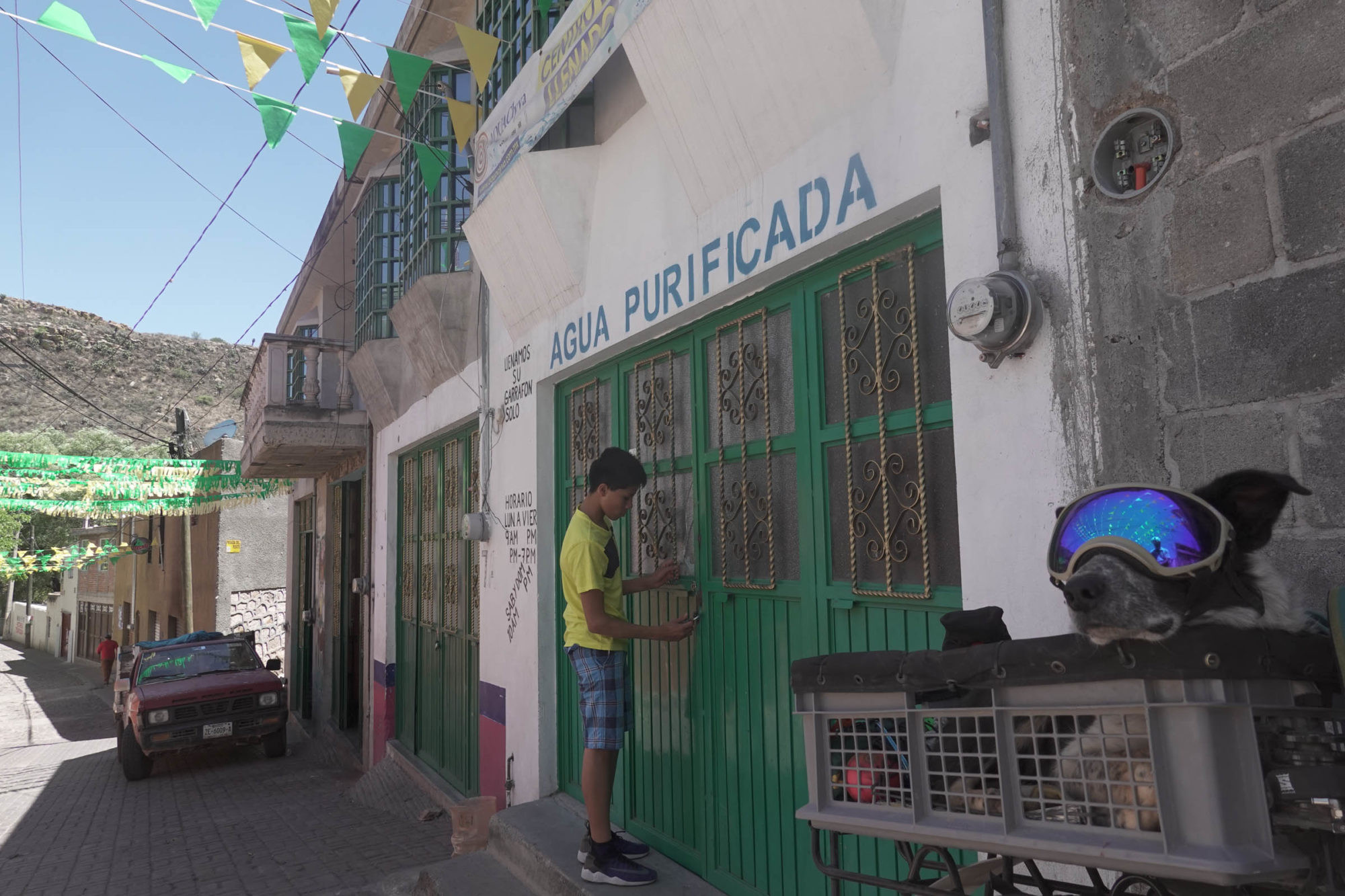 Dog enjoying water during a bikepacking trip
Dog enjoying water during a bikepacking trip
Backcountry campsites may offer seasonal water sources. Towns and gas stations are often willing to provide water upon request. In some areas, purified water refill stations are available for a small fee. Utilize regular bike bottles or specialized dog water bottles for convenient hydration on the move. Consider a dedicated bottle for your dog to maintain hygiene and track individual water consumption. A collapsible bowl or even a plastic bag can serve as a makeshift water bowl during breaks.
Monitoring your dog’s hydration is critical. Upon reaching your campsite, immediately offer water and food and observe their drinking habits. While dogs may drink from natural water sources along the way, exercise caution in areas with potentially contaminated water or parasite risks. In such cases, prioritize treated water for everyone’s safety.
Pacing and Riding Tactics with a Dog and Trailer
Pacing is as vital for your dog as it is for you during a bikepacking trip. Maintaining a steady pace and incorporating regular snack breaks allows both of you to recover effectively and sustain energy throughout the day. A dog running alongside your bike, especially on rugged terrain, can cover significantly more distance than you, adding up to their overall exertion. Observing your dog’s behavior and energy levels throughout the day helps in managing their output. If challenging climbs are anticipated later in the day, limit your dog’s running distance earlier on. GPS dog trackers can be helpful in monitoring distance covered, though not explicitly discussed in the original article.
Several tactics can help manage your dog’s energy, particularly when using a bike dog trailer. On paved roads or smooth dirt paths where cycling speeds are higher, your dog can comfortably ride in the trailer. This is also beneficial on long flat stretches, sharp rocky surfaces, fast descents, or when the ground is too hot for their paws. On climbs or gentler terrain, your dog can run or trot alongside. Using a runner’s leash, attached to your waist and your dog’s harness (never their collar), provides control and assistance. The leash’s elastic section helps maintain slack and prevent tangling. This setup also allows you to assist your dog when they jump in and out of the trailer. Always ensure the bike speed is slow or completely stopped when your dog enters or exits the trailer.
Bike dog trailers, being lower to the ground, generally make it easier for dogs to enter and exit while the bike is moving, particularly for larger or older dogs. However, leash entanglement with wheels is a critical safety concern. Secure the leash to a point away from moving parts, perhaps using a carabiner and zip-tie on a seatpack or rear rack, if applicable. Practice leash management to ensure smooth and safe transitions.
On longer days, use the leash to regulate your dog’s pace and prevent excessive running. However, on safe singletrack trails, allowing your dog to run off-leash can be enjoyable and safer, as they can navigate the terrain freely. Teaching commands like “Back” to keep them behind the bike on singletrack ensures trail visibility and control during encounters with others. Standard commands like left, right, and “this way” also aid navigation. Aim to limit your dog’s daily out-of-trailer running distance based on their fitness level.
Understanding your dog’s capabilities and fitness level is essential to prevent injuries. Dogs naturally tend to sprint and rest rather than maintain a steady pace off-leash. Prepare your dog for dogpacking trips with gradual increases in distance and varied terrains over several weeks of “training” rides or during the initial weeks of a longer tour. Treat your dog like an athlete, ensuring adequate rest and recovery before increasing exertion.
Choosing the Right Bike Dog Trailer
For extended bikepacking trips, especially with medium to large dogs, a bike dog trailer becomes an indispensable piece of equipment. Trailers offer a comfortable and safe space for your dog to rest, especially when covering longer distances, navigating varied terrains, or during inclement weather. Several types of bike dog trailers are available, each with its own advantages.
Single-wheel trailers, like the BOB Yak or Burley Coho XC, are excellent for off-road adventures and singletrack trails. Their design allows for better maneuverability on narrow paths and uneven surfaces. They maintain a low center of gravity, enhancing stability. For compatibility with different bike axle types, consider solutions like the Robert Axle Project. However, be mindful that these trailers are not designed for live loads at high speeds (above 40kmph).
Two-wheeled trailers, often designed for children, are suitable for wider tracks and roads. They offer greater stability on paved surfaces but can be less maneuverable on tight trails. These are a good option for larger dogs or if you have two dogs.
When selecting a bike dog trailer, consider the following factors:
- Size and Weight Capacity: Choose a trailer appropriate for your dog’s size and weight. Ensure they have enough space to comfortably sit, stand, and lie down.
- Terrain Compatibility: Match the trailer type to your intended riding terrain. Single-wheel trailers excel off-road, while two-wheeled trailers are better for smoother surfaces.
- Durability and Construction: Look for robust construction to withstand the rigors of bikepacking.
- Ventilation and Weather Protection: Ensure adequate ventilation for your dog’s comfort, especially in warm weather. Some trailers offer rain covers for protection in wet conditions.
- Padding and Comfort: Padding the trailer floor and walls is crucial for your dog’s comfort and safety, especially on bumpy trails. A comfortable liner can prevent injuries from hard surfaces and vibrations. Consider custom liners, like those previously offered by Porcelain Rocket (now Rockgiest Bikepack USA), or DIY padding solutions.
 Dog comfortably sitting in a bike trailer
Dog comfortably sitting in a bike trailer
A simple splash guard, like a downtube protector for mountain bikes, mounted to the trailer’s front, can shield your dog from spray and debris from your bike’s rear wheel. Eye protection, such as Rex Specs dog goggles, is also recommended to protect your dog’s eyes from sun, wind, dust, and trail debris.
Training your dog to use a bike trailer is essential. Start with short sessions in a familiar environment, gradually increasing duration and introducing varied terrains. Positive reinforcement and treats can make the training process enjoyable.
Special Considerations for Dogpacking with a Trailer
Weight Distribution and Balance
Using a bike dog trailer significantly alters your bike’s handling and weight distribution. The added weight of the trailer and your dog requires adjustments to your riding style. Practice riding with the loaded trailer in a safe area to get accustomed to the changed dynamics. Distribute weight evenly within the trailer and across your bike to maintain balance and stability.
Gearing and Braking
The increased overall weight necessitates lower gear ratios for comfortable climbing. Consider a wider range cassette and a smaller chainring to ease uphill riding. Conversely, the added weight demands more robust braking power, especially on descents. Upgrading to 4-piston calipers and larger rotors (203mm front, 180mm rear) can significantly improve braking performance and heat management. Avoid prolonged brake dragging on descents to prevent overheating and brake fade. Take breaks to allow brakes to cool down on long descents. Carry spare brake pads and be prepared to replace rotors as needed, especially on mountainous routes.
Maneuvering with a Trailer
Maneuvering with a trailer, especially on technical trails or in tight spaces, requires practice and awareness. Take wider turns to accommodate the trailer’s tracking. Be mindful of the trailer’s width when navigating narrow passages. When hike-a-biking, consider the trailer’s added length and weight.
Shelter and Accommodation on Dogpacking Trips
Camping
Wild camping, when practiced responsibly, is a fantastic aspect of bikepacking and often dogpacking. Tents become portable dens for dogs, and most dogs adapt quickly to sleeping in them. Protect your tent’s floor, poles, and inflatable sleeping pads from your dog’s claws. A closed-cell foam pad for your dog provides comfort, warmth, and a protective barrier for the tent floor and can also be used in the bike dog trailer. Dogs often act as early warning systems for approaching animals or people. Consider leashing your dog inside the tent to prevent accidental escapes and tent damage if they become startled.
Regular grooming, even a quick comb before bedtime, is beneficial to keep your tent and sleeping area clean. Check your dog for ticks and paw injuries daily. Keep nails trimmed, though they may naturally wear down on longer trips. Inspect harnesses and collars for wear and tear to prevent irritation.
Camping Alternatives
Hotels, Airbnb, Warm Showers hosts, and welcoming locals can offer alternatives to camping. Pet-friendly accommodations may have limited availability or incur extra fees. When booking online, use “pet-friendly” filters and carefully review pet policies. While not all Warm Showers hosts or hotels welcome dogs, with planning, pet-friendly options can usually be found.
International Dogpacking with a Trailer
International travel with a dog and a bike dog trailer requires meticulous planning and adherence to specific regulations that vary significantly between countries. Start your research well in advance, consulting official government websites for pet import requirements for each country you plan to visit or transit through.
Websites for Canadian (http://www.inspection.gc.ca/animals/terrestrial-animals/imports/policies/live-animals/pets/dogs/eng/1331876172009/1331876307796) and USA residents (http://wwwnc.cdc.gov/travel/page/pets) are good starting points. For European travel, refer to https://europa.eu/youreurope/citizens/travel/carry/animal-plant/index_en.htm.
Land border crossings are often less complex than air travel, though documentation is still essential. Airlines have specific regulations and fees for pet transport, which can vary significantly. Book flights with the same airline for all legs of your journey to potentially simplify pet handling and fees. Layovers exceeding two hours may involve additional pet care fees, but can also provide opportunities for your dog to exercise and hydrate. Always confirm airline-specific pet travel policies and crate requirements before booking.
Dog crates for air travel must meet strict airline regulations. Prepare all required travel documents, including health certificates, vaccination records, and import permits, and bring both originals and copies to the airport check-in desk well in advance of your flight.
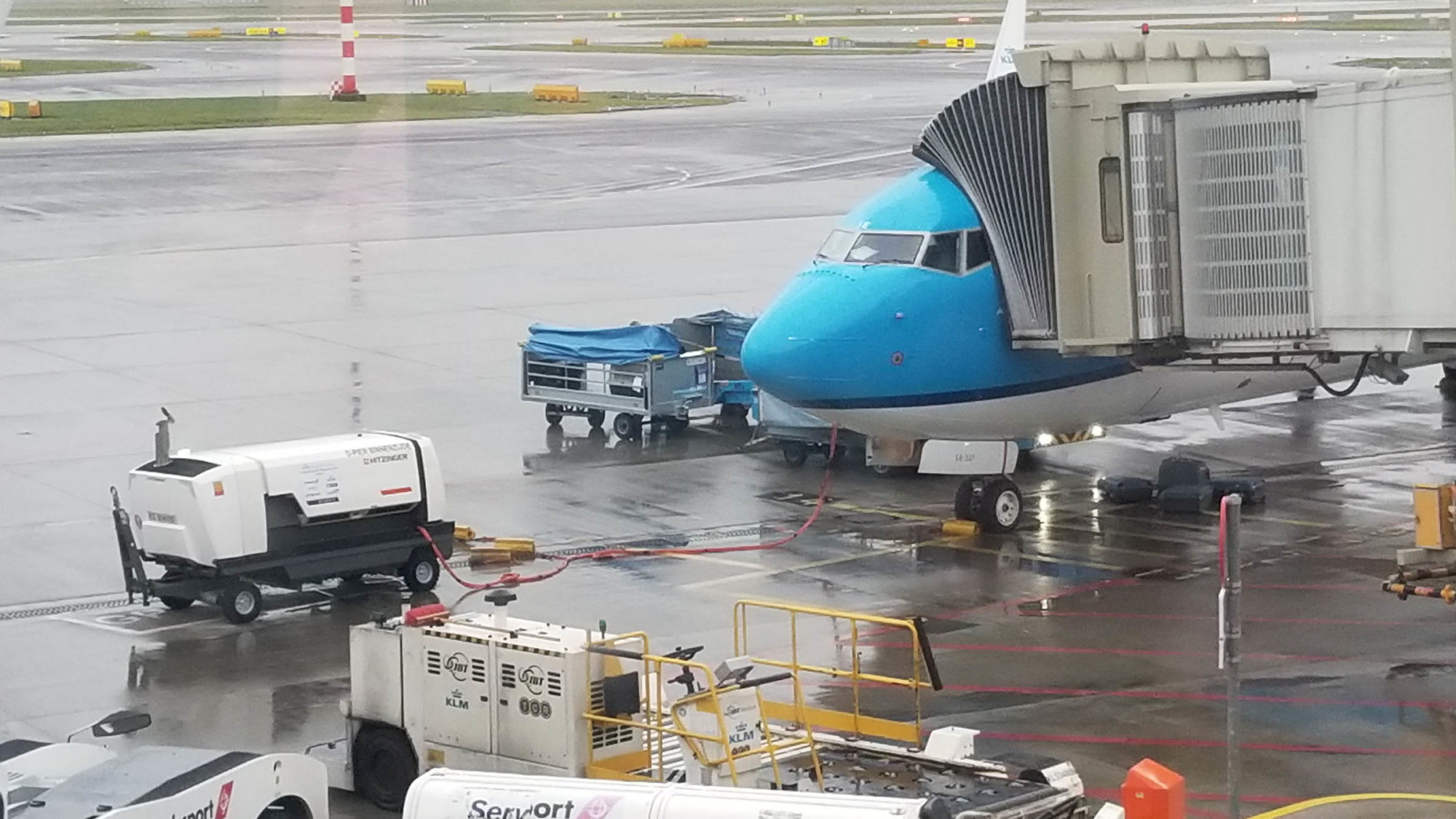 Dog in a travel crate at an airport
Dog in a travel crate at an airport
Being well-prepared for airport procedures minimizes stress and sets a positive tone for your trip. Sedatives are generally discouraged for air travel with dogs and can be risky. Light feeding and water intake well before flying allows time for digestion. Panting in dogs can indicate stress, not just overheating. Smaller dogs may be eligible for in-cabin travel, subject to airline restrictions and fees. Thoroughly review all airline pet travel guidelines before booking your flights.
Always stay updated on travel advisories and border restrictions, as these can change rapidly, especially in response to global events.
Airport Arrival
Traveling with a companion simplifies airport logistics. Solo travelers should anticipate a potentially stressful arrival process. Upon arrival, proceed to baggage claim and oversized baggage areas to collect your bike, trailer, and dog. Luggage carts are essential for managing the extra cargo. Accept offers of assistance from airport staff or fellow travelers. Document your arrival with photos and videos to capture the memory. Airports often have designated dog relief areas, which are crucial for your dog’s immediate needs after a flight.
Dog Health and First Aid on the Road
First Aid
A well-equipped first-aid kit is essential, catering to both human and canine needs. Focus on items for treating road rash from potential crashes. Vetrap is invaluable for securing bandages on both humans and dogs. Lightweight dog booties are useful for protecting paws from hot pavement, sharp rocks, or thorns.
Paw cuts, while often superficial, can bleed profusely. Thoroughly clean and inspect any wounds, no matter how minor. Pack tweezers and a fine-toothed comb for tick removal. While preventative tick/flea medication is helpful, daily tick checks and removal are crucial, particularly in tick-prone areas. Use tweezers carefully to remove embedded ticks.
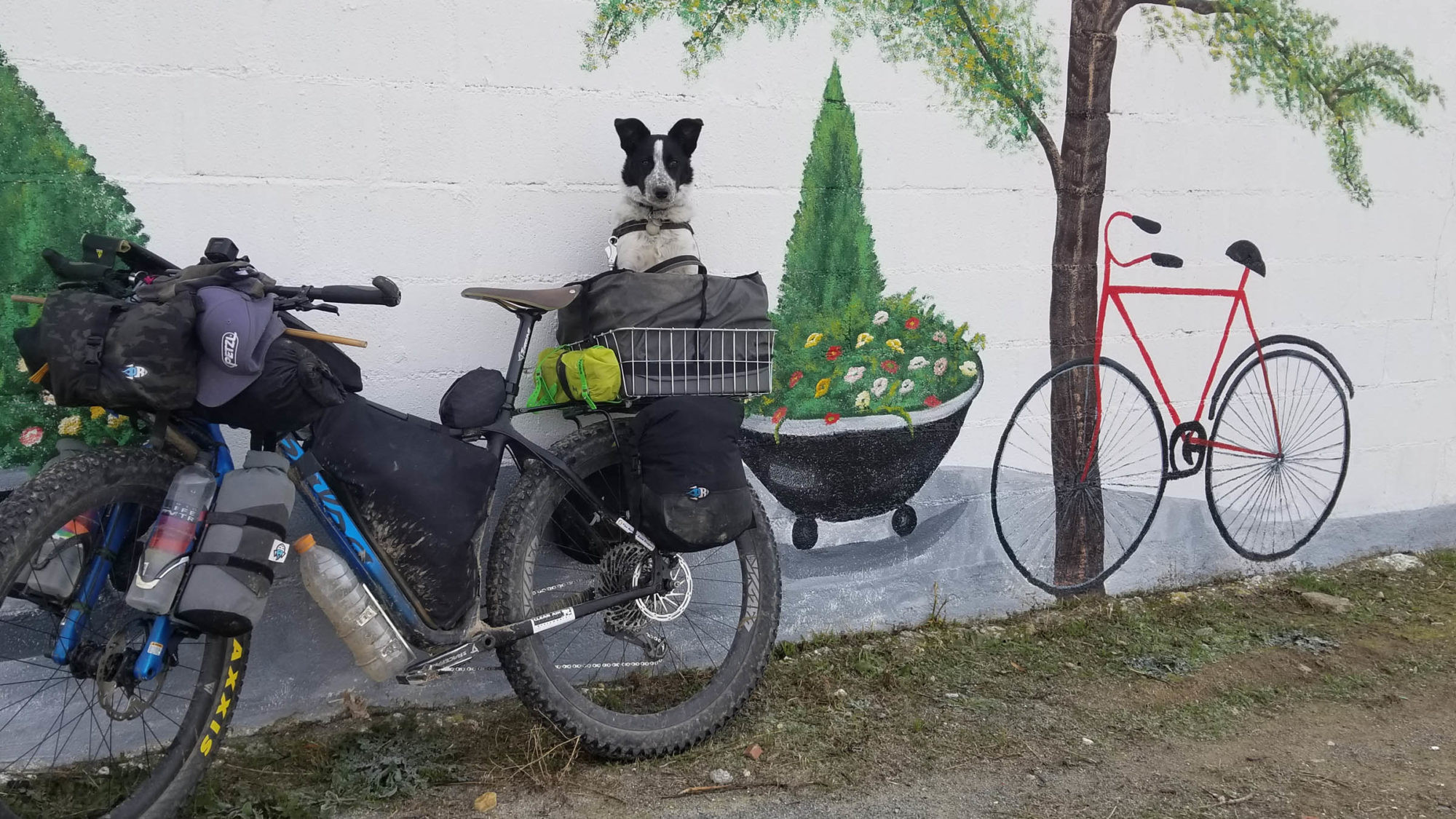 Dog getting first aid attention
Dog getting first aid attention
Eye drops can alleviate eye irritation from dust and wind. Dog goggles, like Rex Specs, offer excellent eye protection against environmental hazards. Consult your veterinarian for recommendations on other necessary medications to include in your first-aid kit.
Dogpacking with Puppies and Trailers
Bringing puppies on bikepacking trips, especially with trailers, requires careful consideration. Puppies are still developing, and excessive running can harm their growing joints. Consult your veterinarian regarding your puppy’s growth plates and appropriate exercise levels for their age.
Introducing puppies to dogpacking at a young age, as early as three months (minimum age for air travel due to vaccination requirements), is possible, as demonstrated by Mira’s early travels. However, be prepared for adjustments. Puppies tire more easily, and you’ll need to carry them more frequently, including lifting them in and out of a bike dog trailer if they are not yet able to jump in and out themselves. Expect shorter daily distances and slower paces. Prioritize your puppy’s well-being and comfort over ambitious mileage goals.
Be extra cautious on rough terrain to prevent injuries to your puppy. Early exposure to diverse environments and consistent companionship during travel can foster a strong bond between you and your puppy.
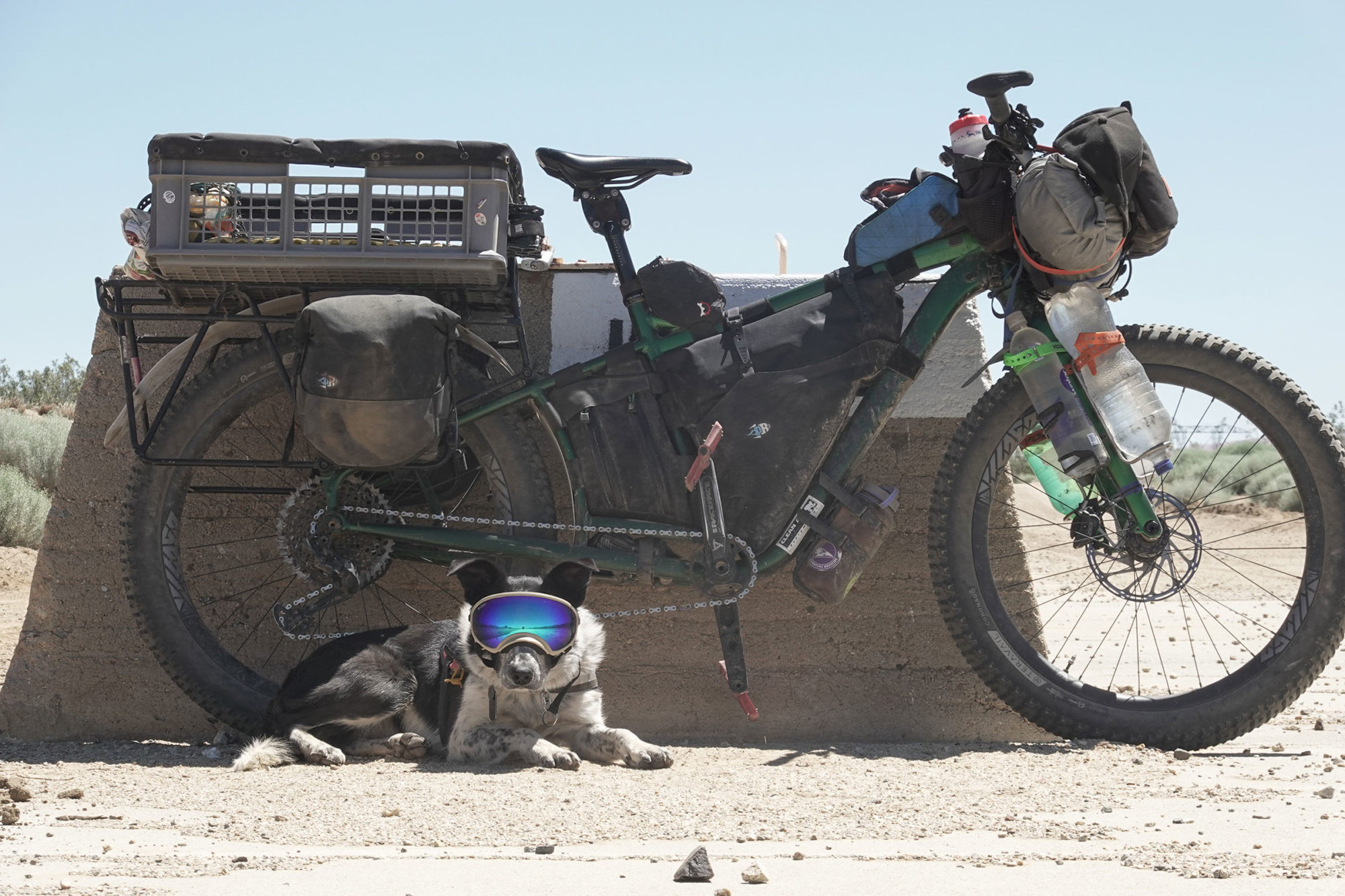 Puppy dogpacking in a basket
Puppy dogpacking in a basket
Final Thoughts
Dogpacking, especially with a bike dog trailer, might seem like a significant undertaking. While it does require extra planning and effort, the unique rewards are immeasurable. Sharing the bikepacking experience with your dog deepens your bond and creates unforgettable memories. The joy of seeing your dog thrive in the outdoors, explore new environments, and share in your adventures makes it all worthwhile. Coasting down a scenic trail with your dog happily riding in their trailer, ready for a scratch behind the ears, is a truly special experience.
If you are considering including your canine friend in your bikepacking adventures, a bike dog trailer can be a game-changer, offering comfort, safety, and enabling longer and more varied trips together. Embrace the journey, prepare thoughtfully, and enjoy the incredible companionship of dogpacking.
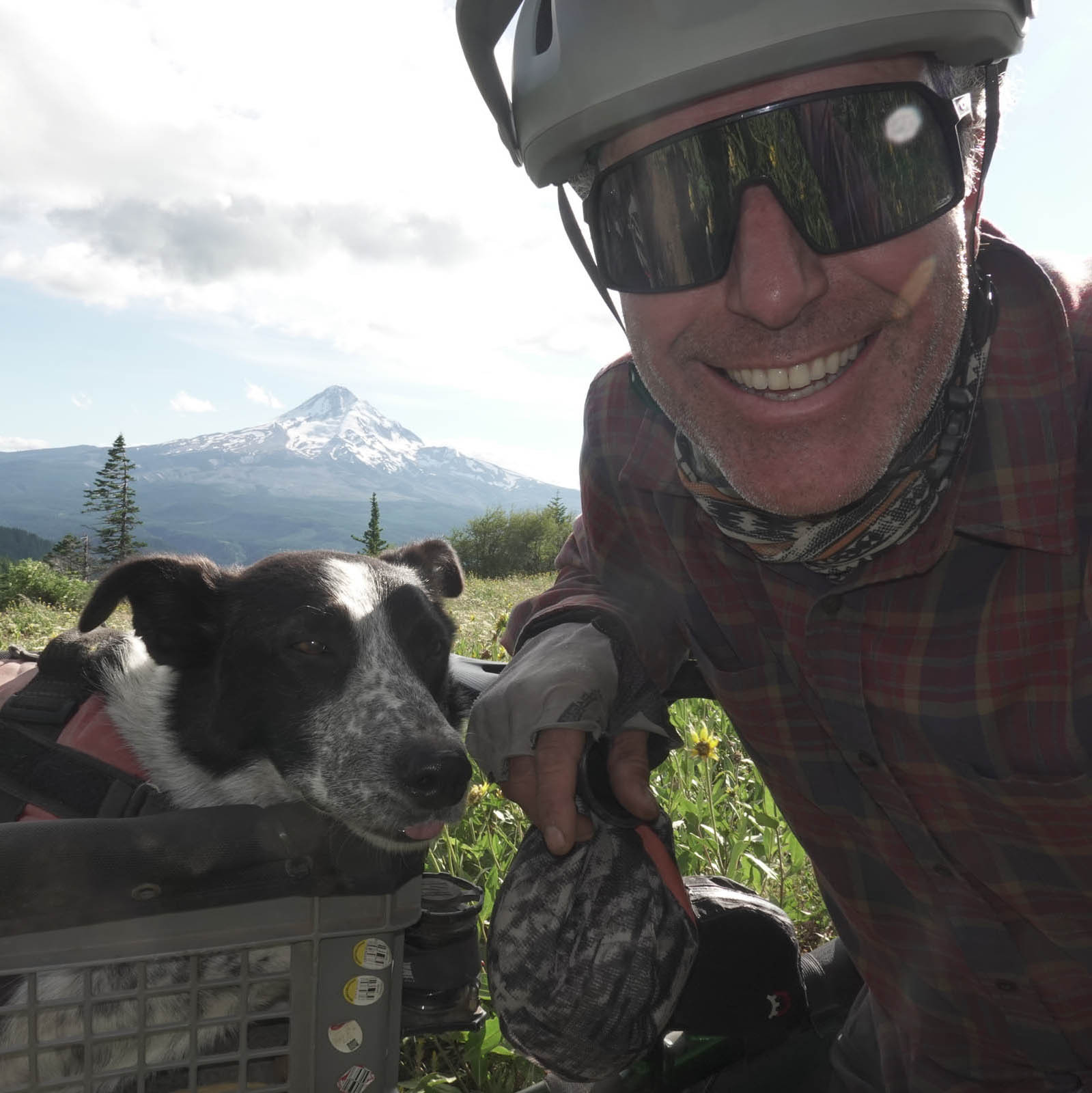 John Freeman and Mira together
John Freeman and Mira together
Q&A
Are you afraid someone will steal your dog while left unattended?
Not usually. If I am, I will ask a local to keep an eye on Mira and the bike. Usually, I come out to find people taking selfies with Mira. I have seen large crowds doing this. Then it’s Q&A time.
How to you handle other dogs, such as aggressive stray street dogs?
We typically just keep riding. Mira ignores them for the most part. A well-timed spray from a water bottle usually does the trick for dogs that didn’t get the memo. A fake or real stone throw can be effective. The advantage of the basket is that it keeps Mira high and safe from other dogs.
What is Mira’s favourite trail snack?
Mira loves cheese, and so do I.
How far do you ride each day?
It depends on the terrain. The average is about 80km with 1,500m elevation gain on good dirt. The range is 30km to 250km (18.6 to 155 mi) with elevation gain up to 3,000m.
How far does Mira run each day?
I try to limit her to under 25km (14 mi). Only what she is fit enough to handle. Sometimes, this means that I have to work extra hard while she is in the basket.
Where does Mira’s name come from?
Travelling through Spain with my previous dog, Melan, people would exclaim to their friends “Mira, mira, mira!” Look, look, look. When Melan died and I found Mira, I thought it would be a great way to continue his memory. It has a nice ring to it as well. It’s funny when I call her in a Spanish speaking country and people look our way.
How much dog food do you carry?
It maxes out at 4kg (8lbs). As little as needed to get to the next shop. Two to three cups per day on average. The brands of dry food do change but I try to blend the new with the old to reduce stomach upset that could be caused by change in diet.
How much water do you carry normally?
Only enough to get to the next water source. Max 15L. Mira drinks from groundwater sources. This helps reduce the amount of water that I need to carry on the bike. I can treat water as needed.
Do you have a YouTube channel?
Yes, find it here. It’s only just started but we will have regular videos uploaded starting later summer 2021. The hope is to share our continuing adventures with everyone who loves dogs, bikes, and travel. We have Instagram and Strava if you’d like to follow there.
How do I know if the trail/road surface is too hot?
Dogs will lift their paws, while standing still, if the surface is too hot. You can also check with a bare hand. If you think it is too hot then it likely is. Asphalt and beach type sand become extremely hot in midsummer direct sun.
Do you have pet insurance?
I don’t, but I am currently researching to see if it is something that may be worth the cost.
How do you protect Mira from cold weather?
I will pack a shelled fleece vest for her during cold trips. Booties will help to protect paws if you expect to encounter salted roads. Also, Mira will have had time to adapt to changing seasons before we head out on a trip.
About John Freeman and Mira
John and Mira have been bikepacking all over North America for the last few years and document their travels on their Youtube channel and Instagram at @mira_la_perra. Make sure to follow along for more dogpacking adventures as they continue their travels on two wheels…
Related Content
Make sure to dig into these related articles for more info…
[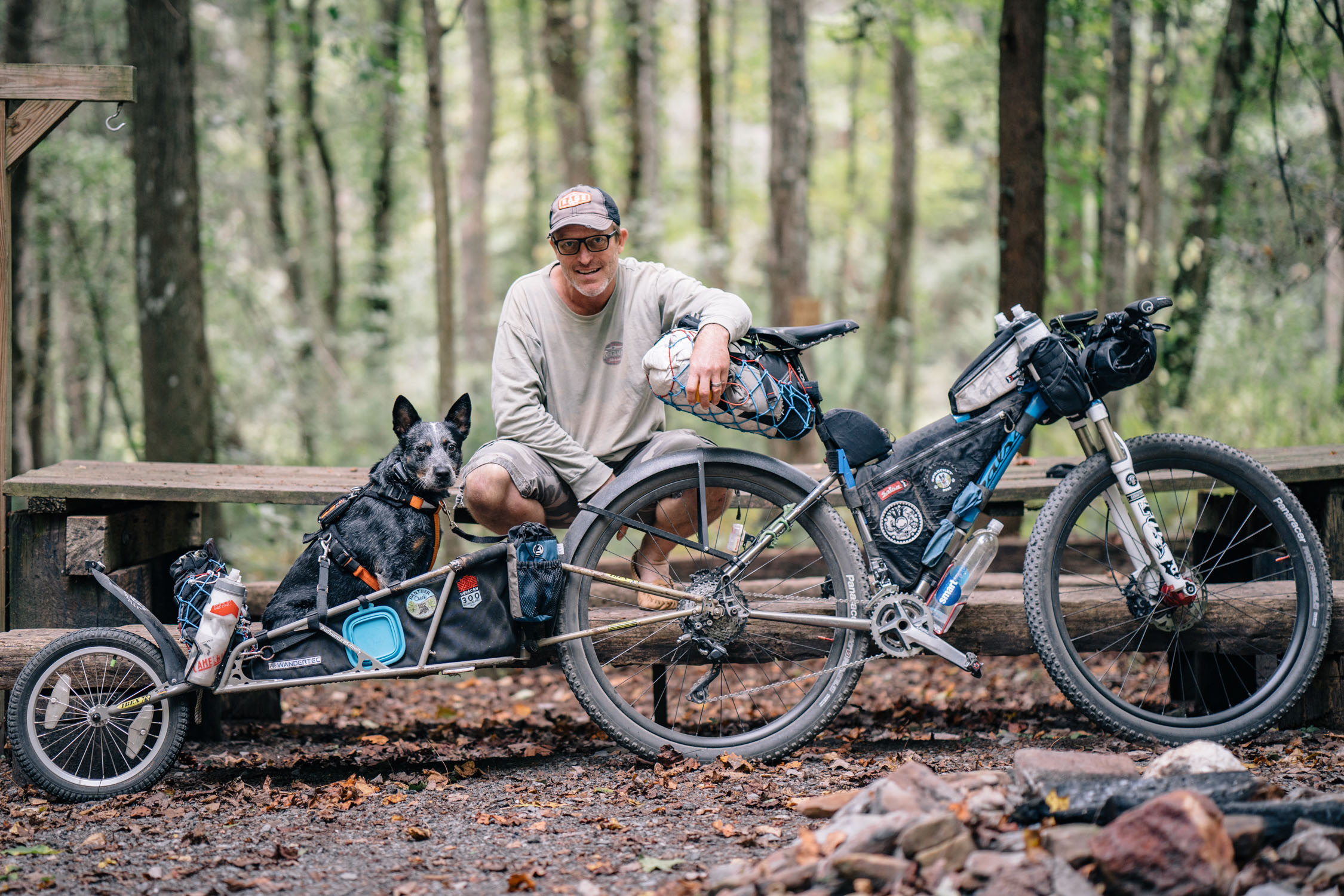 Charlie Kemp, Molly RIder, dogpacking, bikepacking with a dog43
Charlie Kemp, Molly RIder, dogpacking, bikepacking with a dog43
Bikepacking Bikes
Charlie Kemp and Molly Rider’s Dogpacking Rig](https://bikepacking.com/bikes/charlie-kemp-dogpacking-rig/)
[ John Freeman and Mira7
John Freeman and Mira7
Dispatch
John and Mira’s Dogpacking Setup on “The Baja Divide Part 6” Video](https://bikepacking.com/news/john-and-miras-dogpacking-setup-video/)
[ Baja Divide Film, Tales on Tyres, Video5
Baja Divide Film, Tales on Tyres, Video5
Inspiration
12 Most Liked Posts of 2017](https://bikepacking.com/plog/2017-most-liked/)
[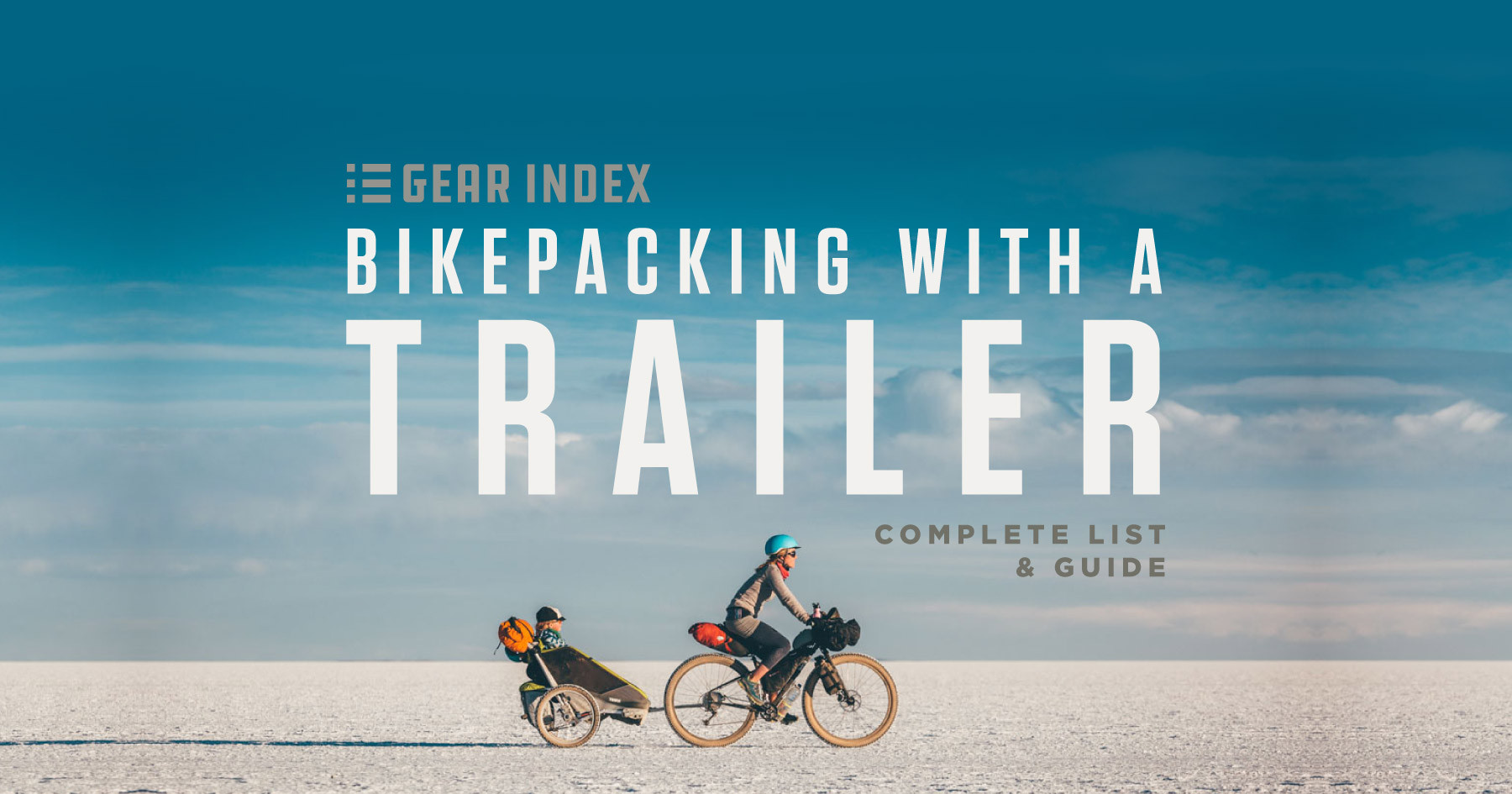 Bikepacking With a Trailer, list of bicycle trailers124
Bikepacking With a Trailer, list of bicycle trailers124
Accessories
